|
|
 |
Fiche d'espèce de Copépode |
|
|
Calanoida ( Ordre ) |
|
|
|
Arietelloidea ( Superfamille ) |
|
|
|
Heterorhabdidae ( Famille ) |
|
|
|
Paraheterorhabdus ( Genre ) |
|
|
|
Paraheterorhabdus ( Sous-Genre ) |
|
|
| |
Paraheterorhabdus (Paraheterorhabdus) vipera (Giesbrecht, 1889) (F,M) | |
| | | | | | | Syn.: | Heterochäta vipera Giesbrecht,1889; 1892 (p.373, 383, figs.F, no M);
Heterorhabdus tenuis Tanaka, 1964 a (p.20, Descr.M, figs.M); ? Roe, 1975 (p.346, fig.M, Rem.); ? Nishida & Ohtsuka, 1996 (p.620, figs.F: Md ); Lozano Soldevilla & al., 1988 (p.59); Hidalgo & al., 2010 (p.2089, Table 2);
Heterorhabdus (Paraheterorhabdus) compactus : Chihara & Murano, 1997 (p.819, Pl.122: M);
Heterorhabdus (Paraheterorhabdus) vipera : Chihara & Murano, 1997;
Heterochäta vipera Giesbrecht,1889; 1892 (p.373, 383, figs.F, no M);
Heterorhabdus vipera Giesbrecht & Schmeil, 1898 (p.116, Rem. F, no M); Pearson (1906, p.26); Wolfenden, 1911 (p.303); Farran, 1926 (p.284); Rose, 1933 a (p.205, figs.F, non M); Lysholm & al., 1945 (p.36); Farran, 1948 e (n°16, p.3, figs.F, non M); Tanaka, 1964 a (p.17, figs.F); Park, 1970 (p.523, figs.F,M, Rem); Harding, 1974 (p.141, tab. 3, gut contents); Roe, 1975 (p.346, No fig.M); Deevey & Brooks, 1977 (p.256, tab.2, Station "S"); Guangshan & Honglin, 1984 (p.118, tab., Rem.: p.165); Shih & Young, 1995 (p.70); Bradford-Grieve & al., 1999 (p.883, 944, figs.F,M); Hernandez-Trujillo & Esqueda-Escargera, 2002 (in Appendix); Hsiao & al., 2004 (p.326, tab.1); Vives & Shmeleva, 2007 (p.310, figs.F,M, Rem.);
Heterorhabdus tenuis Tanaka, 1964 a (p.20, Descr.M, figs.M); ? Roe, 1975 (p.346, fig.M, Rem.); ? Nishida & Ohtsuka, 1996 (p.620, figs.F: Md ); Lozano Soldevilla & al., 1988 (p.59); Vives & Shmeleva, 2007 (p.312, figs.M, Rem.);
Heterorhabdus (Paraheterorhabdus) compactus : Chihara & Murano, 1997 (p.819, Pl.122: M);
Heterorhabdus (Paraheterorhabdus) vipera : Chihara & Murano, 1997 (p.820, Pl.122: F,M).
Ref. compl.: Sewell, 1932 (p.300); 1948 (p.503, 522, 548, 558, 561, 567, 568); Morris, 1970 (p.2301); Park, 1970 (p.477); Roe, 1972 (p.277, tabl.1, tabl.2); Vives, 1982 (p.293); Greze & al., 1985 (p.7); Lapernat, 2000 (tab.3); Lopez-Salgado & al., 2000 (tab.1);
Paraheterorhabdus vipera : Dur & al., 2007 (p.197, Table IV); | | | | Ref.: | | | Park, 2000 (p.83, figs.F,M, Rem.) | 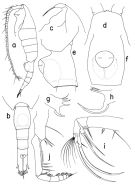 issued from : T. Park Bull. Scripps Inst. Oceanogr. Univ. California, San Diego, 2000, 31. [p.206, Fig.54].
Female: a, habitus (left side); b, urosome (dorsal); c, d, forehead (left, dorsal, respectively); e, f, genital somite (left, ventral, respectively); g, masticatory edge of right Md (posterior); h, masticatory edge of left Md (posterior); i, left Mx2 (posterior); j, right Mxp (anterior).
|
 issued from : T. Park in Bull. Scripps Inst. Oceanogr. Univ. California, San Diego, 2000, 31. [p.207, Fig.55]. Female: a, exopod of P1 (anterior); b, P5 (anterior). Male: c, urosome (dorsal); d, P5 (anterior); e, right P5 (with endopod omitted), anterior; f, right P5 (posterior); g, basipod of right P5 (anterior); h, left P5 (with exopod omitted), anterior; i, left P5 (with endopod omitted), posterior; j, second exopodal segment of left P5 (anterior).
|
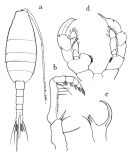 issued from : O. Tanaka in Publs Seto Mar. Biol. Lab., 1964, XII (1). [p.20, Fig.183]. As Heterorhabdus tenuis. Male: a, habitus (dorsal); b, Mxp; c, Md (biting edge); d, P5. Nota: The urosome segments and furca are in the proportional lengths as 15:17:18:15:10:25 = 100. Right A1 extends about to the end of the 2nd urosome segment. The furcal rami slightly asymmetrical (left ramus: longer).
|
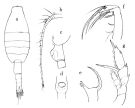 issued from : O. Tanaka in Publs Seto Mar. Biol. Lab., 1964, XII (1). [p.18, Fig.181]. Female: a, habitus (dorsal); b, A1; c, last thoracic segment and genital somite); (lateral left side); d, genital somite (ventral); eMd (biting edge); f, Mx2; g, P5. Nota: The urosome segments and furca are in the proportional lengths as 39:16:14:8:23 (left) = 100. A1 extends to the end of the anal segment (when fully reflexed).
|
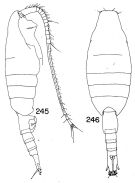 Issued from : T. S. Park in Bull. Mar. Sc., 1970, 20 (2). [p.521, Figs.245-246]. As Heterorhabdus vipera. Female (from Caribbean Sea & G. of Mexico): 245, habitus (lateral right side); 246, idem (dorsal). Nota: Posterolateral corner of metasome in dorsal view triangularly produced.
|
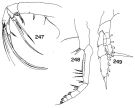 Issued from : T. S. Park in Bull. Mar. Sc., 1970, 20 (2). [p.522, Figs.247-249]. As Heterorhabdus vipera. Female: 247, Mx2; 248, Mxp; 249, P5 (anterior).
|
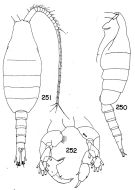 Issued from : T. S. Park in Bull. Mar. Sc., 1970, 20 (2). [p.522, Figs.250-252]. As Heterohabdus vipera. Male (from Caribbeann Sea & G. of Mexico): 250, habitus (lateral left side); 251, idem (dorsal); 252, P5 (anterior).
|
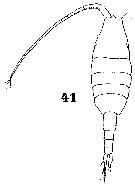 Issued from : W. Giesbrecht in Systematik und Faunistik der Pelagischen Copepoden des Golfes von Neapel und der angrenzenden Meeres-Abschnitte. – Fauna Flora Golf. Neapel, 1892. Atlas von 54 Tafeln. [Taf. 39, Fig. 41]. As Heterochäta vipera. Female: 41, habitus (dorsal).
|
 Issued from : W. Giesbrecht in Systematik und Faunistik der Pelagischen Copepoden des Golfes von Neapel und der angrenzenden Meeres-Abschnitte. – Fauna Flora Golf. Neapel, 1892. Atlas von 54 Tafeln. [Taf. 20, Fig.5]. As Heterochätaviperai. Female: 5, endopod of Mx1.
|
 issued from : H.S.J. Roe in Bull. British Mus. (Nat. Hist.) Zool., London, 1975, 28 (7). [p.345, Fig.23, g]. As Heterorhabdus tenuis. Male (Cape Verde Islands): g, P5. Bar scale 0.1 mm. The present males agree with the descriptions of Tanaka (1964) and Park (1970, as H. vipera male. The differences in P5 between H. tenuis and H. vipera can be seen clearly by comparing Figs. 23 g and 23 f. In H. tenuis the basipodite 2 of the left leg has a haired inner margin and the exopodite 3 of the right leg has a haired inner margin and the exopodite 3 of the right leg is a totally different shape to that of H. vipera. Both endopodites have 3 segments and are omitted for clarity.
|
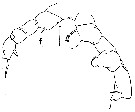 issued from : H.S.J. Roe in Bull. British Mus. (Nat. Hist.) Zool., London, 1975, 28 (7). [p.345, Fig.23, f]. As Heterorhabdus vipera. Dobtful. Male (Cape Verde Islands): f, P5. Bar scale: 0.1 mm. Nota: For Roe (1975, p.346) the males of H. vipera and H. tenuis Tanaka (1964 have been confused. park (1970) described the male of H. tenuis as H. vipera (Roe (1972), and since the present material includes both species it seems advisable to illustrate the differences in their P5. The present specimen differ slightly from that of Giesbrecht (1892) by having 1 spine on the basipodite 2 of both legs, and by having an outer edge spine on the 2nd exopodite of the right leg.
|
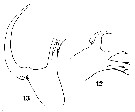 Issued from : W. Giesbrecht in Systematik und Faunistik der Pelagischen Copepoden des Golfes von Neapel und der angrenzenden Meeres-Abschnitte. – Fauna Flora Golf. Neapel, 1892, 19 , Atlas von 54 Tafeln. [Taf.20, Figs.12, 13]. As Heterochäta vipera. Female: 12, right Md (mamandibular edge); 13, left Md (mandibular edge). Nota: Same scale.
|
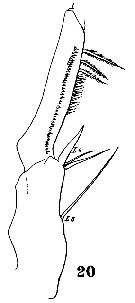 Issued from : W. Giesbrecht in Systematik und Faunistik der Pelagischen Copepoden des Golfes von Neapel und der angrenzenden Meeres-Abschnitte. – Fauna Flora Golf. Neapel, 1892, 19 , Atlas von 54 Tafeln. [Taf.20, Fig.20]. As Heterochäta vipera. Female: 20, Basipodite segments 1 and 2 of Mxp (anterior surface).
|
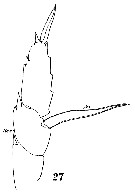 Issued from : W. Giesbrecht in Systematik und Faunistik der Pelagischen Copepoden des Golfes von Neapel und der angrenzenden Meeres-Abschnitte. - Fauna Flora Golf. Neapel, 1892. Atlas von 54 Tafeln. [Taf. 20 , Fig.27 ]. As Heterochäta vipera. Female: 27, exopd of P5. Re = exopod; Si = inner seta.
|
 Paraheterorhabdus (Paraheterorhabdus) vipera Paraheterorhabdus (Paraheterorhabdus) vipera female: 1 - Left caudal ramus distinctly longer than right and completely fused with anal segment (Fig.54-b) 2 - Dorsally, posterolateral corners of prosome angular (Fig.54 a-b). 3 - Laterally, 2nd urosomal somite (Fig.54-a) without a swelling along ventral margin. 4 - Laterally, posterior slope of genital prominence straight (Fig.54-e). 5 - Genital somite distinctly longer than wide (Fig.54-b).
|
 Paraheterorhabdus (Paraheterorhabdus) vipera Paraheterorhabdus (Paraheterorhabdus) vipera female: 1 - Left caudal ramus distinctly longer than right and completely fused with anal segment; setation in both rami as in female (Fig.55-c). 2 - Basis of right P5 with wide, rectangular inner lobe (Fig.55-g). 3 - Exopod of right P5 tapering distally into a single ptocess (Fig.55-e); 2nd lobe of Mx2 (Fig.54-i) with a short seta.
| | | | | Ref. compl.: | | | Schnack-Schiel & al., 2010 (p.2064, Table 2: E Atlantic subtropical/tropical); Hsiao S.H. & al., 2011 (p.475, Appendix I); Bonecker & a., 2014 (p.445, Table II: frequency, horizontal & vertical distributions) | | | | NZ: | 13 | | |
|
Carte de distribution de Paraheterorhabdus (Paraheterorhabdus) vipera par zones géographiques
|
| | | | | | | | | | | | | Loc: | | | E South Africa, off Tristan da Cunha E, off Ascension Is., off SW St. Helena Is., Cape Verde Is., off NW Cape Verde, Morocco-Mauritania, Canary Is., Brazil (off Rio de Janeiro), off Amazon, Caribbean Sea, G. of Mexico, Sargasso Sea, off Bermuda (Station "S"), off E Cape Cod, off Madeira Is., Portugal, Bay of Biscay, off N Azores N, W Ireland , W Medit. (Alboran Sea), Natal, Mozambique Channel, Laquedive Is., N Indian, Indian (E equatorial), China Seas (East China Sea, South China Sea), Taiwan (SW, E), Japan (Sagami Bay), Pacif. (W equatorial), Salomon Is., Pacif. (tropical central: N-S), Pacif. (E tropical: N-S), off Hawaii (S, N), Chile (S) | | | | N: | 31 | | | | Lg.: | | | (38) F: 2,63; M: 2,68; (46) F: 2,8; (88) F: 2,4-2,16; (121) F: 2,16; (199) F: 2,66-2,36; M: 2,51-2,43; ? (199') M: 2,51-2,28; ? (808) F: 2,53-2,35; {F: 2,16-2,80; M: 2,43-2,68} | | | | Rem.: | méso-bathypélagique.
Park (2000) n'évoque pas les références de Roe (1975) et de Nishida & Ohtsuka (1996).
Voir aussi les remarques en anglais | | | Dernière mise à jour : 07/12/2020 | |
|
|
 Toute utilisation de ce site pour une publication sera mentionnée avec la référence suivante : Toute utilisation de ce site pour une publication sera mentionnée avec la référence suivante :
Razouls C., Desreumaux N., Kouwenberg J. et de Bovée F., 2005-2025. - Biodiversité des Copépodes planctoniques marins (morphologie, répartition géographique et données biologiques). Sorbonne Université, CNRS. Disponible sur http://copepodes.obs-banyuls.fr [Accédé le 03 juillet 2025] © copyright 2005-2025 Sorbonne Université, CNRS
|
|
 |
 |

















